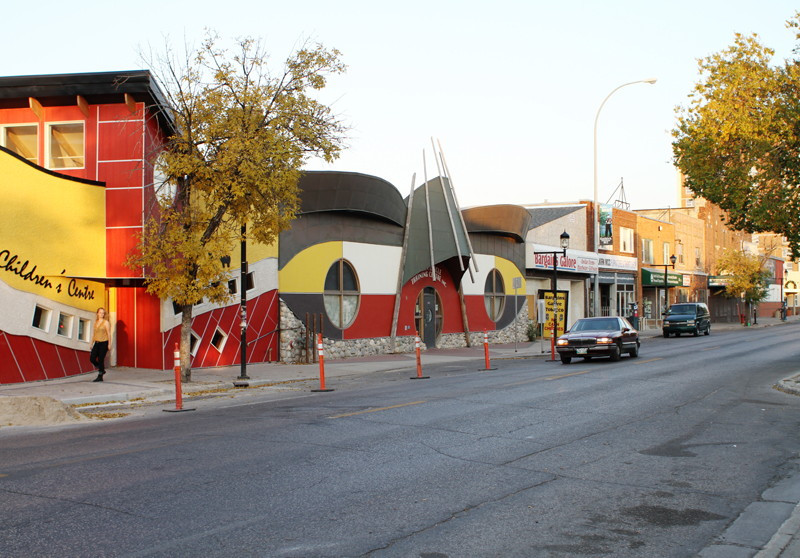What’s the U of W doing in the North End?
Exciting new developments in the revitalization of Selkirk Avenue
The University of Winnipeg’s Department of Urban and Inner-City Studies (UIC) is located on Selkirk Avenue, in Winnipeg’s North End - and exciting things are happening there.
Selkirk Avenue
In the first half of the 20th century Selkirk Avenue was the bustling commercial heart of Winnipeg’s North End. Busy shops lined both sides of the street, shopkeepers spoke a variety of Eastern European languages and shoppers were shoulder to shoulder on a Saturday.
In the post-war period Selkirk Avenue began a long and steep decline - empty lots and boarded up buildings replaced busy shops.
Today, Selkirk Avenue is beginning a comeback, led by a variety of innovative post-secondary educational initiatives.
In fact, the street can now be thought of as an alternative education hub. The hope is that it will soon be the site of a North End Community Campus.
The Inner City Social Work Program
The University of Manitoba’s Inner City Social Work Program (ICSWP) has been in operation for 30 years.
It moved into a strikingly renovated building on Selkirk Avenue in 2005 and offers a bachelor of social work to people who have grown up in poverty.
It provides a variety of supports, uses innovative educational techniques, and has produced 500 qualified social workers - many of whom work in the inner city in a variety of capacities.
As a result, many of the inner city’s most effective community leaders are ICSWP graduates.
Urban Circle Training Centre
The Urban Circle Training Centre offers a variety of post-secondary programs that produce skilled health, education and community workers.
Urban Circle relocated to Selkirk Avenue at about the same time as the ICSWP, and is located in a renovated building with a dramatic aboriginal design.
All of Urban Circle’s students and most of its teaching staff are aboriginal, and Urban Circle may well be the best aboriginal adult education program in Canada.
Its teaching strategy includes a strong emphasis on building students’ awareness of and pride in their aboriginal identity. A recent cost-benefit analysis concluded that, by making it possible for so many people to move from social assistance into the paid labour force, Urban Circle has saved Manitobans $53.5 million in taxes from 1990 to 2010.
Department of Urban and Inner-City Studies
In the summer of 2010 the U of W’s Department of Urban and Inner-City Studies (UIC) moved to Selkirk Avenue where it offers a degree program in urban studies with a difference - a strong emphasis on the lives of those who are marginalized, and on community development and community activism.
UIC moved to the North End to attract U of W inner-city residents, aboriginal people and newcomers.
Today, between 40 and 50 per cent of UIC students are aboriginal or newcomer and/or inner-city residents, and the interaction between them and the growing numbers of students from the main campus is exciting.
Makoonsag
In January 2012, the 52-space Makoonsag Intergenerational Childcare Centre opened, with first priority going to students in the Selkirk Avenue education hub.
Most of the staff are aboriginal, and elders play a cultural role.
The renovated building features a beautiful aboriginal design, and Makoonsag removes a big barrier to post-secondary education for many inner-city students.
Merchants Corner
The next step in this process involves what was the Merchants Hotel, which used to be a magnet for negative and often illegal activity on Selkirk Avenue.
A North End community coalition has worked, with support and funding from the province, to acquire the building and six adjoining lots, and is now in the process of redeveloping the space.
As adequate and affordable housing is in short supply, Merchants Corner will include a 20-25 unit student housing complex. It will also include retail space and a full floor of post-secondary education programs,
including UIC, some Red River College programs, the North End high school support program and Community Education Development Association’s Pathways to Education program.
What might be thought of as a North End community campus is taking shape.
Education and Poverty
Education on its own cannot solve the deep poverty that exists in Winnipeg’s inner city.
However, innovative educational initiatives such as those on Selkirk Avenue can play a significant role in the battle against poverty.
And in the process, Selkirk Avenue, the former commercial heart of the North End, is being revitalized.
Jim Silver is chair of the Department of Urban and Inner-City Studies. His next book, Moving Forward and Giving Back: Aboriginal Adult Education in Winnipeg’s Inner City, will be published by Fernwood in February 2013.
Published in Volume 67, Number 5 of The Uniter (October 3, 2012)







